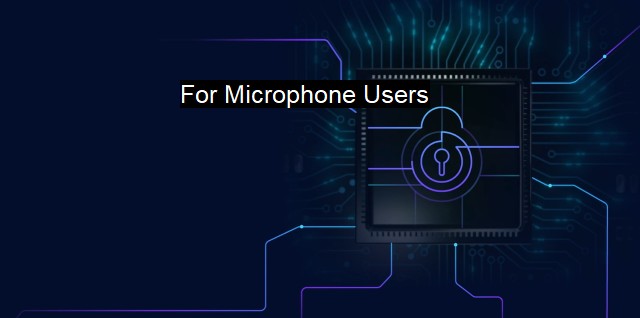What are For Microphone Users?
Balancing productivity and security: Exploring cybersecurity and antivirus solutions for microphone users
The realm of cybersecurity and antivirus efforts continues its expansion across various facets of our tech-dominated life. As we experience an increasing dependency on the internet and digital communications, we must recognize the vulnerabilities that tag along. Among this, the usage of microphoness ought to be looked at through the prism of cybersecurity, as cyber attackers understand the broad array of potential opportunities offered to them via this medium.The microphone, an integral component of our different devices, such as smartphones, tablets, and laptops, is often the gateway for intrusion by cyber miscreants. It serves the functions of enhancing two-way communications, sending voice commands, and other multimedia applications. burgeoning technology trends increase security vulnerabilities and cybersecurity threats for microphone users.
Skilled cyber attackers can capitalize on weak cybersecurity strategies to convert microphones into spy bugs, often without the user's knowledge. This malicious intrusion usually focuses on voice data, confidential information, discussions, and conversations. Due to our frequent reliance on remote communication in our digital era, the peril of such attacks becomes even more significant.
So, how does this intersection of cybersecurity and microphone use actually play out? In most instances, these malicious activities are motivated by social engineering goals which aim to exert influence or control over specific individuals or systems. A trojan horse application can host hazardous software that records or intercepts audio data, thus transmitting that data back to the attacker. It immensely emphasizes the strategic implication of cybersecurity measures for microphone users.
The risk broadens with the evolution in technologies. Network protocols like VoIP could be subjected to Man-In-The-Middle (MITM) attacks, where the attacker secretly alters and relays the communication between two parties who believe they're communicating with each other directly. This can result in eavesdropping, wherein the attacker could retrieve sensitive information.
Microphones are intrinsic components of the Internet of Things (IoT). The attackers have the opportunities to exploit the vulnerabilities of IoT devices to obtain unauthorized access, leading to the potential theft or manipulation of voice data. Cyber-attacks targeting IoT devices have shown upward trends. Thus, antivirus programs must be vigilant about protecting the multiple entrance points that microphones typically offer.
The contemporary malware typologies, combined with artificial intelligence, can even decipher human conversations, transforming them into text and analyzing them for specific keywords. This can often lead to hackers deriving value from seemingly harmless conversations, emphasizing the essential role of robust cybersecurity strategies.
Taking all these threats into account, it's only logical that no microphone user should remain unprotected or fail to heed this new frontier of cybersecurity. In fact, implementing robust antivirus software that is capable of detecting potential malicious attacks or suspicious activities should be every microphone user’s first line of defense. Strong encryption tools for VoIP calls can also strengthen the response to cybersecurity threats.
Adopting an encryption means that even if the attacker succeeds in intercepting the voice command or conversation, they would find it insurmountable to decode it, ensuring the safety of the data. Usage of dependable virtual private networks (VPNs) can also help validate traffic and ward-off any harmful or dubious software trying to channel through the VPN implying, the microphone, in turn, remains secured.
Ongoing research in microphone technology also seeks to design mics with embedded encryption mechanisms, ensuring secure interactions and shielding from potential cyber attacks. As the cybersecurity landscape evolves, the implementation of sound safety measures could help alleviate the risks for microphone users. In turn, this reinforces the importance of being cyber-secure in our burgeoning digital age.

| | A | | | B | | | C | | | D | | | E | | | F | | | G | | | H | | | I | | | J | | | K | | | L | | | M | |
| | N | | | O | | | P | | | Q | | | R | | | S | | | T | | | U | | | V | | | W | | | X | | | Y | | | Z | |
| | 1 | | | 2 | | | 3 | | | 4 | | | 7 | | | 8 | | |||||||